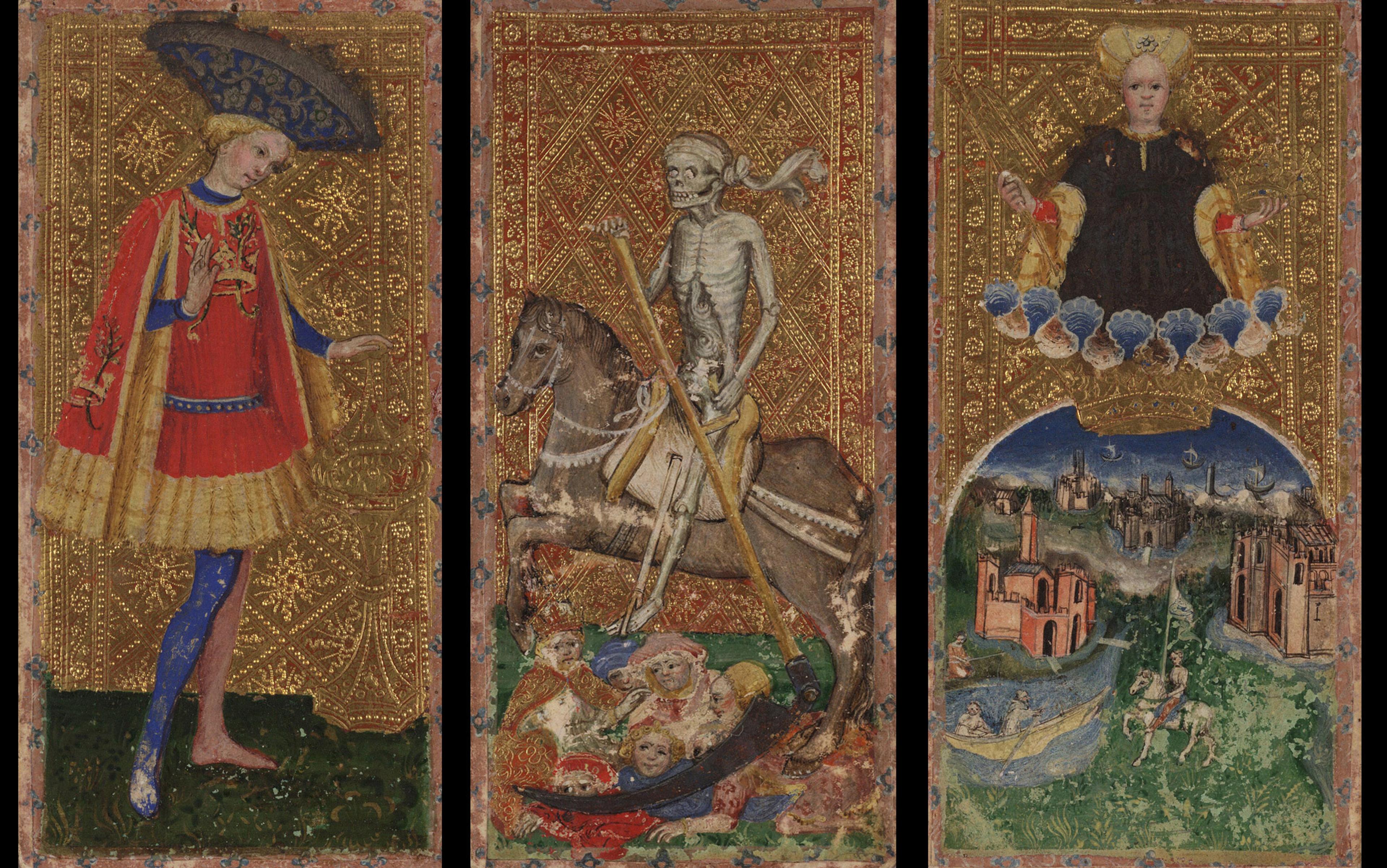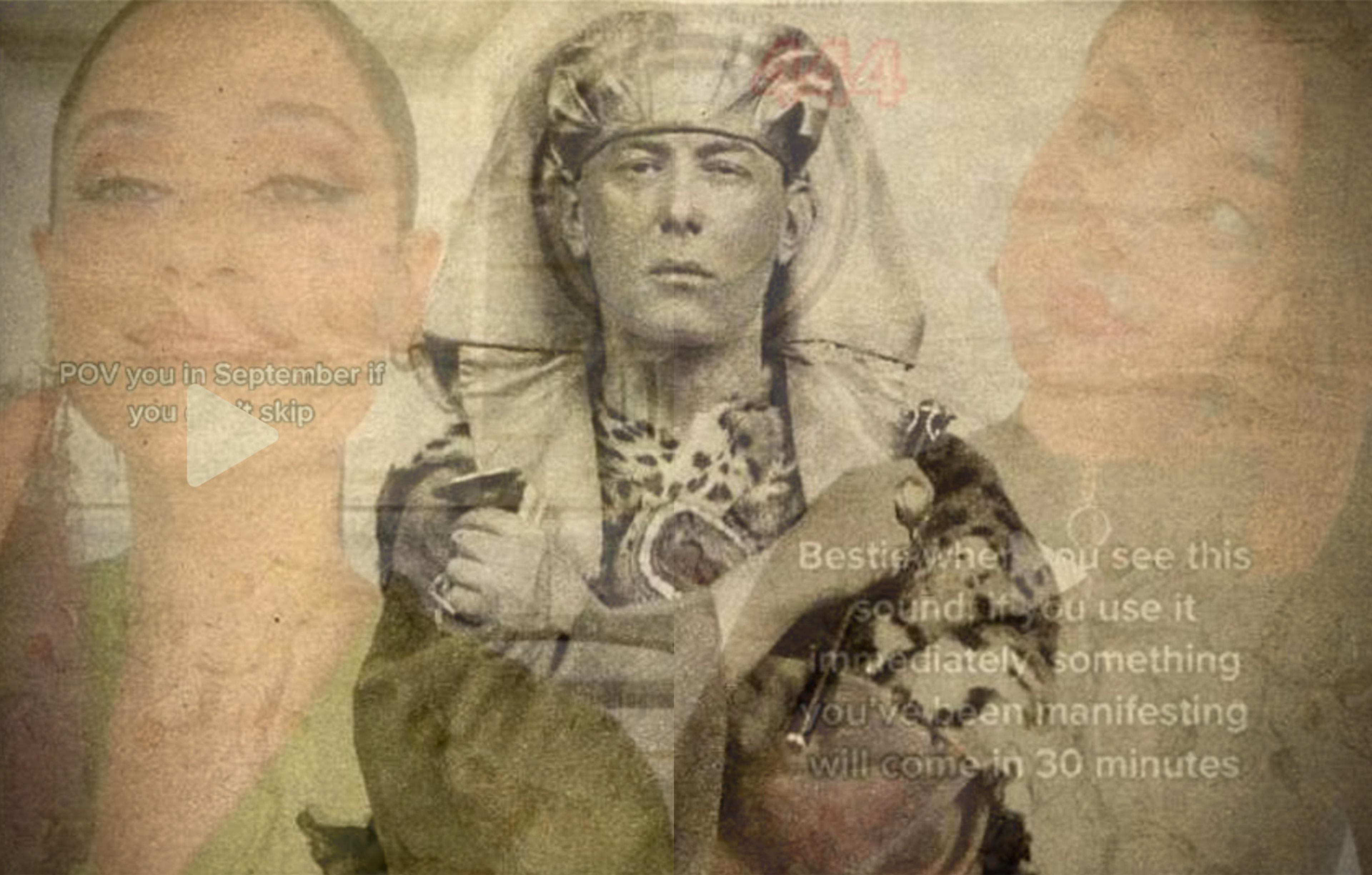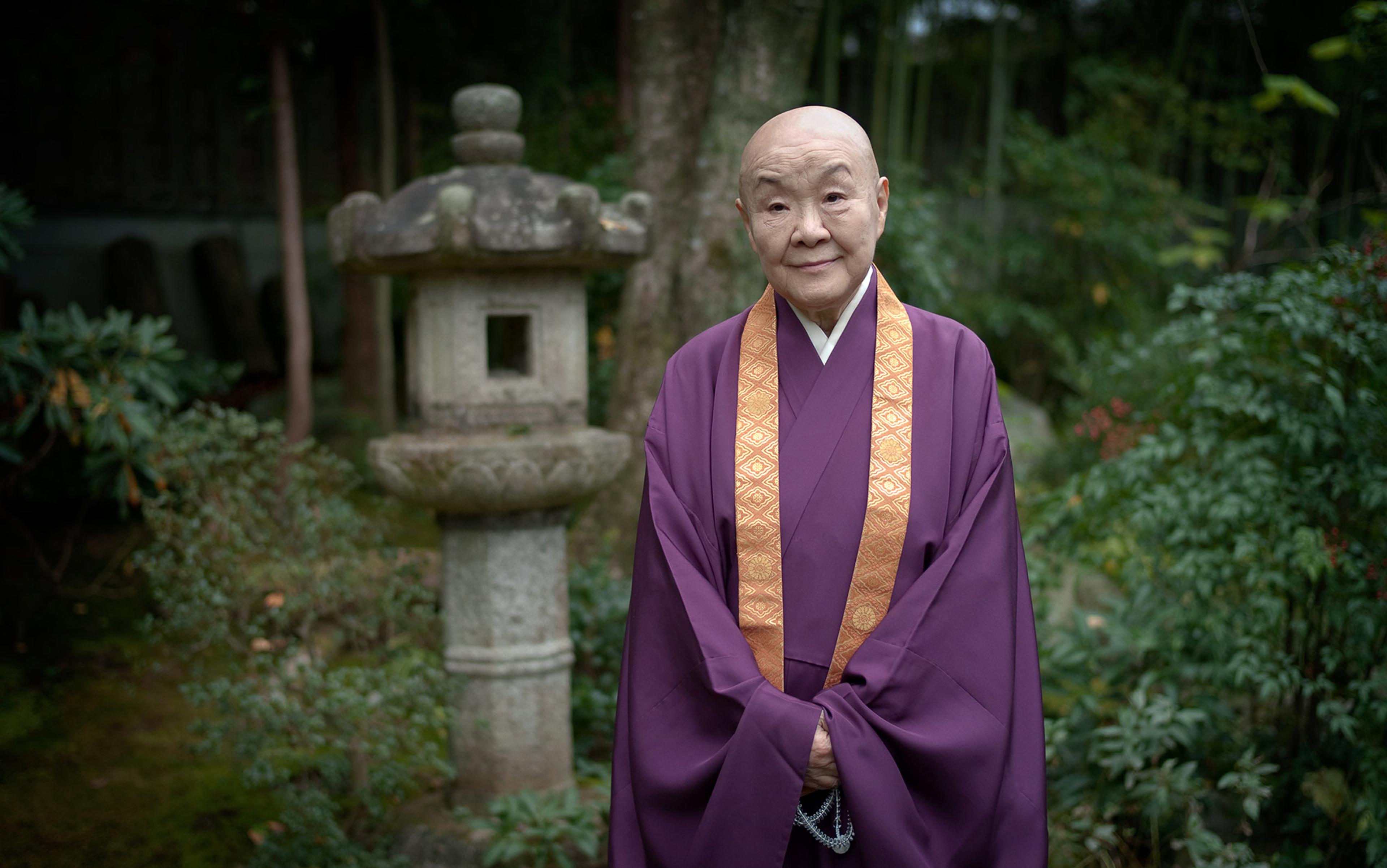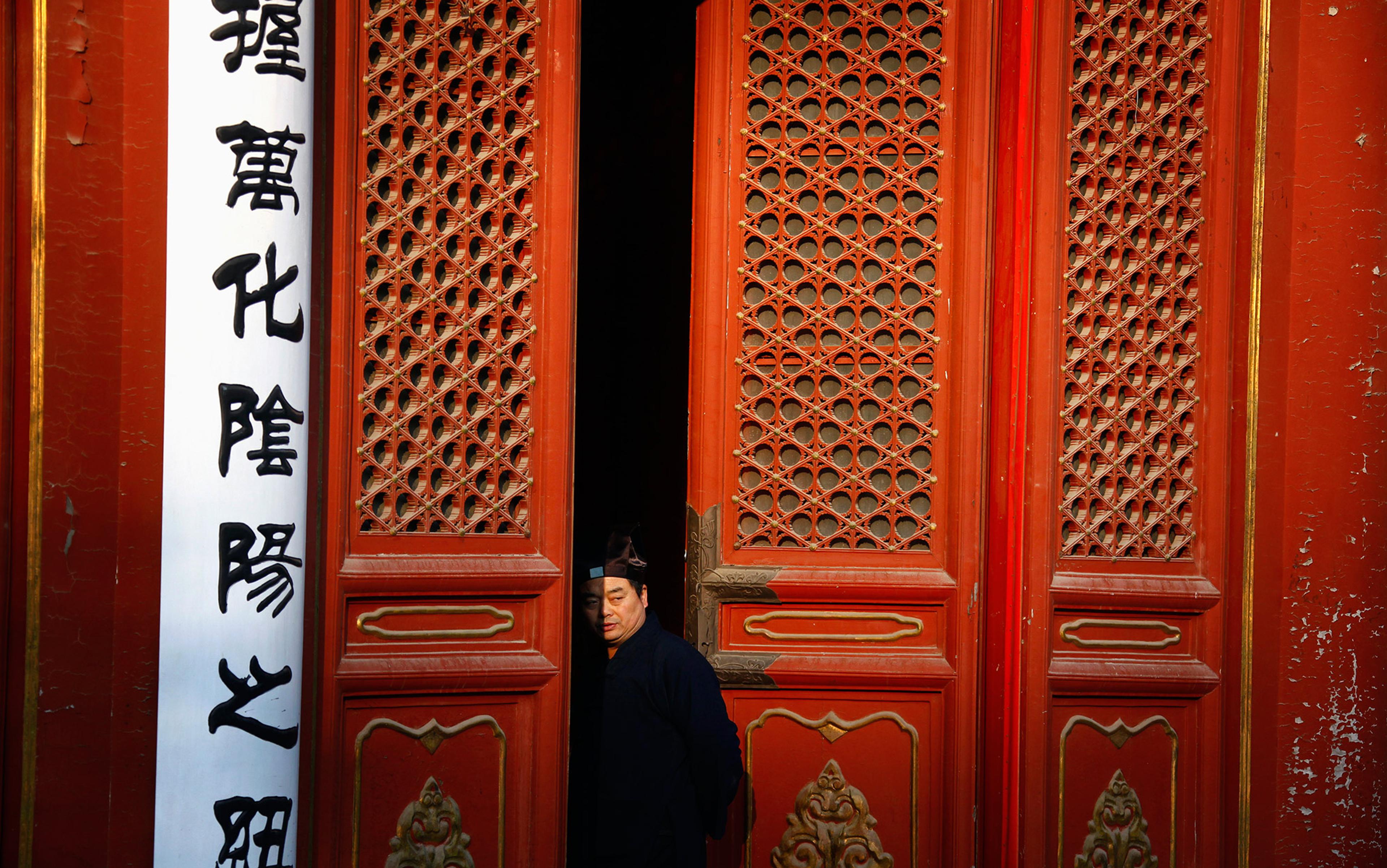There are clues that this is no ordinary suburban living room. For one, we’re in Glastonbury. Then there’s the perfumed candle, the Buddha figure, the cloth draped over the television and, not least, the worn little wooden box that sits atop an occasional table hung with black silk. Inside it are 78 tarot cards. I have come to Glastonbury as a ‘querent’ – which is what tarot practitioners call a customer. A querent, traditionally, comes with a question. I have several. Assuming that tarot cards do not work as a method of reading the future, why does tarot persist? How has tarot survived as an object, a practice, a text, and a peculiarly velvety strand in European popular culture? Where did something so strange, dream-like and overburdened with symbolism come from?
In Glastonbury’s bookshops, alongside sections on stone circles, crystals and Kabbalah, I find whole shelves devoted to tarotology. Most books are by practitioners, repeating versions of the same origin myth. Tarot cards encode ancient wisdom, chiefly ancient Egyptian (but incorporating influences from Kabbalah to Celtic). Some tarotologists identify Romany fortunetellers as the custodians of that wisdom, drawing on the old European belief that ‘gypsies’ are of Egyptian origin.
The notion that tarot cards somehow survived the cultural wreck of ancient Egypt has a surprisingly specific origin: Paris, 1781, when France seethed with secret societies and private clubs. Some were radically political, as would soon bear fruit. Many more had pretensions to having privileged access to occult traditions.
Freemasonry was the most fashionable of these societies, with its claims to a heritage deriving from the Knights Templar, and back further, from the architects of Solomon’s temple itself. But it bobbed in a rich esoteric stew that looks familiar to any observer of the present-day ‘New Age’: Rosicrucianism, theosophy, Swedenborgianism, Mesmerism, Martinism, Hermeticism (believed to derive ultimately from the ancient Egyptian god Thoth). Esoteric ideas and traditions were widely explored, elaborated and, often, invented.
The mood has been dubbed ‘anti-Enlightenment’ – or Counter-Enlightenment, to use Isaiah Berlin’s term. It owes something to the Romantic taste for the exotic and mystical, though anti-clerical and anti-authoritarian impulses were present too. Delving into ‘dark’ mysteries was conceived as an intellectual and ethical riposte to the hyper-rationalism of ‘enlightened’ secularism. Emanuel Schikaneder’s libretto for Mozart’s opera The Magic Flute (1791) frames the opposition neatly by setting the crepuscular, murderously matriarchal Queen of the Night against Sarastro, the rationalist, Masonic, Isis-and-Osiris-worshipping priest of the Sun.
Ancient Egypt was particularly fashionable in early 1780s Paris. (And not just in Paris: the Great Seal of the United States, with its prominent pyramid and Masonic eye, was designed in 1782.) Between 1781 and 1785, the Italian charlatan Giuseppe Balsamo, the self-styled Count Cagliostro, founded his own Egyptian ‘rite’ of Freemasonry. A fashionable Cagliostro lodge was reported in 1785 as being decorated with statues of Egyptian gods, hieroglyphics, a stuffed ibis and an embalmed crocodile.
Another prominent Parisian Freemason – as well as scholar and Protestant pastor – was Antoine Court de Gébelin. In 1781, he published the eighth volume of his Le Monde primitif, analysé et comparé avec le monde moderne, in which he unwearyingly sought etymological and allegorical correspondences through history. At one much-cited moment he lurches into anecdote. He visited a ‘Madame la C d’H’, he says, and found her playing cards with other ladies. Court de Gébelin was seized by an overwhelming conviction. Imagine, he suggests:
If I was to announce that an ancient Egyptian work still exists today, a book that escaped the flames which devoured their superb libraries, and that contained the purest teaching on the most interesting of subjects … If I added that this book was widespread across much of Europe, and that for several centuries it had been in all our hands … that the fruit of such an exquisite wisdom was looked upon as a heap of extravagant figures that signified nothing other than themselves … would you not think that I was amusing myself by playing with the credulity of my readers?
Au contraire, Court de Gébelin insisted, this matter was ‘très-vrai’. Tarot cards amounted to a secret book of 78 pages – the remnant of the ‘lost’, magical Book of Thoth. It had never been noticed before because the cards had been so ‘little dignified by attention’.
What is striking about Court de Gébelin’s revelation is that Madame la C d’H and her friends were not using the cards for divination – no one had thought of that yet – but simply as playing cards. The jeu de tarot involved bidding for contracts and taking tricks, rather like bridge.
The tarot deck contained four main suits of swords, cups, coins and batons, which correspond to spades, hearts, diamonds and clubs. The card ‘Le Fou’ (madman, or joker) acts as a sort of super-trump, and an extra ‘knight’ card sits between Jack and Queen. More significantly, tarot decks also contained a separate suit of elaborately depicted figures, named ‘trumps’. In fact, the game was known simply as ‘trumps’, in English, which expresses how mystical it was.
The four suits have been speculatively linked to the four castes of Vedic India, the four ‘estates’ of medieval society (nobility, clergy, burghers, peasants), Plato’s four cardinal virtues of Fortitude, Prudence, Temperance and Justice – and many other tetrads besides. With better evidence, they have been traced to the early Chinese playing-card symbols of Cash, Strings of Cash, Myriads of Strings, and Tens of Myriads.
However, the immediate source for the suits of European tarot was uncovered in 1939, when the archaeologist Leo Mayer found a 15th-century deck of Mamluk tarot cards in Istanbul’s Topkapi Palace. The correspondences revealed are temptingly neat. Children inducted into the Mamluk military slave retinue progressed through the ranks from page to equerry to khassakiyah, or elite soldier. The most trusted khassakiyah carried symbols of office, including the cup (the cup-bearer), sword (sword-bearer), and polo stick – emblems that were frequently depicted on coins. The polo stick was presumably translated into the baton or club by mystified Italian Renaissance card-makers who made the first European tarot decks, copied from the east.
The Mamluk origin theory is the best on offer, but it is not definitive. Nor does it explain the separate suit of 21 named trumps: the Magician, Empress, Tower, Moon and so on – 22, including the Fool. They emerged later, in the aristocratic courts of the Italian Renaissance – as is suggested by tarot’s original name. In 15th-century Italy, the cards were known as trionfi. They drew from the imagery of the ‘triumphs’, or allegorically themed carnival parades, of which modern carnival floats are the descendants.
Even at the very birth of tarot, card-makers cherrypicked from diverse traditions, seizing on the allegories that suited them
Tarot historians – few of them orthodox scholars – have long sought to reduce the symbolism of the triumphs, or ‘trumps’, to a single system. In 1966, the librarian Gertrude Moakley pinned them to Petrarch’s much-depicted poem sequence I Trionfi, which charted the procession of the allegorical figures Love, Chastity, Death, Fame, Time and Eternity. In 1972, the writer on the occult Paul Huson linked them to the late-medieval artistic tradition of the Danse Macabre, in which a host of tarot-like characters – the Pope, Emperor, Death – processed to the grave. Most recently, in A Cultural History of Tarot (2009), the Australian scholar Helen Farley detailed close allegorical correspondences between the trumps and the values asserted by Filippo Maria Visconti, the early 15th-century Duke of Milan whose court produced the most influential painted deck.
However, Farley admits that tarot’s themes were ‘drawn from a common pool of symbolism’. Which allegorical figure made it to which pack might have been arbitrary or accidental. The late 15th-century deck known as the ‘Sola-Busca’ was probably Venetian or Ferrarese, featured a cast of predominantly Classical characters, and drew on alchemical ideas. An early 97-card Florentine deck also incorporated extra trumps whose names were drawn from the three theological virtues (Faith, Hope, Charity), the four elements and 12 signs of the zodiac, while the ‘standard’ Visconti-Sforza deck, for some reason, has only three of the cardinal virtues: Prudence is missing.
Even at the very birth of tarot, then, card-makers were cherrypicking from diverse traditions, and seizing on the allegories that suited them. The beguiling obscurity of the symbolism lent itself to the process. So it’s almost surprising that the idea of using tarot for divination took so long to emerge. But, like the cards’ supposed ancient Egyptian origin, this notion belongs very specifically to the 1780s.
Shortly after Court de Gébelin went to press, Jean-Baptiste Alliette, a seller of prints and entrepreneurial astrologer, wrote a series of books and manuscripts under the pseudonym ‘Etteilla’ (which is Alliette, reversed), offering ‘A Way to Entertain Oneself with a Pack of Cards’. His method was to renumber the cards so as to ‘correctly’ render their Hermetic-Egyptian-astrological significance, and then follow the techniques of cartonomancie, or card-drawing, as detailed in his previous publications. A reader might thus ascribe particular meanings to the cards drawn, according to which way round they faced.
Etteilla’s method might have vanished, had it not been taken up by the man who did more than any other to translate the esoteric ideas of the anti-Enlightenment 18th century into the occult ideas of the spiritualist-minded 19th century. Alphonse-Louis Constant was a failed trainee priest and once-imprisoned radical who became obsessed by kabbalistic ideas, and he wrote under the name of Éliphas Lévi, which was how he rendered his name in Hebrew.
Constant/Lévi was struck by the coincidence between the number of tarot trumps, the letters in the Hebrew alphabet, and the paths along the kabbalistic Tree of Life: 22. He devised a system of arcane correspondences, disgorging a fresh wave of potential symbolic associations between individual cards and occult wisdom traditions, incorporating astrology, Mesmerism and alchemy, as well as the Kabbalah. Lévi wrote that a prisoner with no books, but only the tarot and the knowledge of how to use it, could ‘acquire universal wisdom, and speak on any subject with unequalled knowledge and inexhaustible eloquence’.
Tarot’s association with gaming is as significant as its links with the occult
The Anglophone occultists who read Lévi took him at his word. The great propagators of his ‘kabbalistic’ tarotology were members of the late 19th-century Hermetic Order of the Golden Dawn. This fashionable magical-esoteric society included such luminaries and poets as Aleister Crowley, William Butler Yeats and Arthur Edward Waite. Crowley brought notoriety, and an all-devouring syncretism: his own ‘Thoth tarot’ deck, illustrated by Lady Frieda Harris, was exhibited in 1942 at London’s fashionable Berkeley Galleries. The contribution of Yeats and Waite was even more influential. Together, they introduced ‘Celtic’ and Arthurian strands to tarot symbolism, while Waite also devised the tarot divination deck that has since become virtually standard in the Anglophone world, in collaboration with a US artist, Pamela Colman Smith.
If the tarot deck has been subjected to intense research, much of it imaginative, the techniques that tarot readers use are rarely discussed. This might be because of their embarrassingly prosaic origin. Informal cartomancy, or fortunetelling using playing cards, is probably as old as cards themselves, and relates to folk practices including Bibliomancy, or opening the Bible at random, and the Biblical casting or Roman drawing of lots. Cartomancy began to reach a mass market, however, not long after the birth of ‘occult’ tarot in the 1780s.
The major figure seems to have been the early 19th-century celebrity fortuneteller Marie Anne Lenormand. She used a 36-card deck derived not from ancient Egypt or the Kabbalah, but from a German parlour game published in around 1800: the Game of Hope. The cards would be laid out in a square, and players would move their tokens around the cards as on a conventional board, seeking to get home.
For all its neglect, tarot’s association with gaming is as significant as its links with the occult. When the philosopher Michael Dummett wrote the first scholarly, and skeptical, history of tarot in 1980, he attracted stung responses for his focus on the game, not its occult significations. The poet William Empson, no less, wrote to the London Review of Books in September 1980 to protest that ‘nobody in the Renaissance would invent such a random thing without making it symbolical’; that ‘the picture cards of the tarot are rather aggressively mysterious’; and that the tarot pack was unlikely ‘used merely for games’. Dummett replied that: ‘Intellectuals, scholars and other serious-minded people are prone to consider playing games a trivial occupation,’ yet in the courts of early Renaissance Italy, by contrast, ‘men and women did not despise games as trifling, but cultivated them and took them seriously, by which I do not mean portentously.’
The same is true of tarot today. There is a hardcore of occult-minded tarotologists, but many others dabble, collect or simply play. Anecdotally, tarot appears to be relatively popular among adolescents and young people. This is certainly the last time I heard anyone talking about it – and it is what the anthropologist Laura Miller found in her 2011 study of tarotto, ‘an under-analysed girls’ culture pastime’ in Japan. The cards now sit alongside other commodified and highly marketed occult play objects, notably the ouija board (itself dreamed up and marketed as a parlour game by a US inventor and lawyer in the 1890s). Tarot cards, in short, are a packaged form of folk wisdom you can buy for a small sum. They mostly come with a Little White Book tucked into the box, offering a basic guide to methods and interpretations.
Committed tarot readers divide broadly into two schools: those who think that the cards help them access unconscious wisdom (the ‘soft’ version), and those who believe that the deck channels the supernatural or even incorporates its own spiritual power (the ‘hard’ school). This presumably explains the practice of wrapping the cards in a black or otherwise precious cloth (that, or apeing the religious practices surrounding holy books for visual effect).
Julie, my tarot reader, encompasses both soft and hard positions. She says that the cards are ‘just a tool’. Of course, ‘they all have meanings’, and the position of the card in the layout ‘gives me an explanation as to why the card is there’ – but she also wants to trust ‘the other side of my brain, which is the feminine, intuitive, meditative’ side. A reading, for her, is about ‘tuning into’ her ‘gut instincts’, not predicting the future: ‘The future is not set in stone,’ she says, ‘you have options, and sometimes what a reading is about is helping you to see those options.’
Before I met Julie, and before researching tarot, I had assumed that ‘card reading’ is nothing more than a ‘cold reading’ of the client, not unlike the Sherlock Holmesian trick of paying close attention to physical and social clues – of proffering canny guesses in such a way that they can be quickly developed or withdrawn. Ray Hyman’s classic article for the Skeptical Inquirer in 1977 outlines the ‘stock spiel’ in 13 tips, including: ‘gain [the client’s] cooperation in advance’ and ‘use the technique of “fishing” – this being “simply a device for getting the subject to tell you about himself. Then you rephrase what he has told you into a coherent sketch and feed it back to him.”’ Tarot cards were covered under tip 5 – ‘use a gimmick’ – which allows the cold-reader to dazzle, distract and stall for time, while appearing to consult the cards.
The true power of tarot reading, however, is not based on simple or cynical guesswork. The querent is complicit in the process. What drives this complicity was first measured in 1949, when the psychologist Bertram Forer asked his students in Los Angeles to fill out what he told them was a personality test, the ‘Diagnostic Interest Blank’. When Forer handed back the ‘results’, he told his students that they were based on the tests. In fact, he had culled 13 broad-brush statements from published horoscopes, including such devastating insights as ‘You have a great deal of unused capacity which you have not turned to your advantage’ and ‘At times you are extroverted, affable, sociable, while at other times you are introverted, wary, reserved.’ No! You too?
Every student was asked to assess the test’s accuracy on a scale of 0 to 5, where 5 indicated perfection. Their average score, astonishingly, was 4.26. Feeling smugly sure that I wouldn’t have fallen for it myself, I spoke to the psychologist Christopher French, who researches paranormal beliefs at Goldsmiths, University of London. He told me that most of the 13 personality descriptions in Forer’s original test are ‘two-headed statements that describe the human condition – and that’s why they resonate so much’. If they don’t describe you, French delightedly tells his own students, ‘you’re probably a psychopath’. But the universality of the statements is only part of the point: Forer’s experiment demonstrated that the statements were not perceived as universal but as highly individual.
When a tarot reading is momentarily inaccurate, we ignore or forget it. When it hits the mark, we are struck by its success
The advantages that the ‘Forer effect’ offers the tarot reader are obvious, especially given the later finding that, when ‘a lot of mumbo jumbo is associated with the procedure’, as Hyman puts it, the effect is reinforced, not weakened.
Confirmation bias is also at work. We prefer to have our existing beliefs confirmed, and selectively pay attention to statements that perform this happy function for us. So when a tarot reading is momentarily inaccurate, we ignore or forget it. When it hits the mark, we are struck by its success.
Tarot reading works, ultimately, because we make ourselves the willing victims of our cognitive biases. Under the influence of false-pattern detection, or apophenia, we turn the string of necessarily disconnected statements made by a medium or tarot reader into a coherent narrative in which we are the hero. (And plain old flattery amplifies the effect. I certainly came away from my reading feeling pleased with the thoughtful, insightful, loving nature Julie so rightly identified.) It has long been advantageous to our species to pay close attention to the context within which messages emerge. But as Hyman sums up: ‘[T]his powerful mechanism can go astray in situations where there is no actual message being conveyed.’
Still, the question remains as to whether tarot readers are well-meaning but credulous, or cynical and exploitative. It is surely relevant that the Forer effect was quickly renamed the ‘Barnum effect’ by the psychologist Paul Meehl, after the circus impresario and serial hoaxster P T Barnum. Alongside his own entertainments – the ‘Fiji Mermaid’, the original ‘Tom Thumb’ – Barnum devoted time to exposing what he regarded as the more culpable fraudulence of spirit mediums and clairvoyants: his book The Humbugs of the World (1866) had the universally scouring subtitle An Account of Humbugs, Delusions, Impositions, Quackeries, Deceits and Deceivers Generally, in All Ages.
During my own reading, I couldn’t help but notice Julie’s version of the contractual small print. ‘It’s like tuning in a radio station,’ Julie warned. ‘Sometimes the information I get through might not be terribly clear, so I might ask for clarity … And if I’m going off on the wrong track, you must say.’ She guarded against the possibility that my skepticism might derail things. ‘The more open you can be, the more I will pick up … It’s like an exchange of energies.’
While French insists that, typically, tarot is ‘an unintentional’ form of cold reading, Julie seemed to me to be entirely sincere. Her ‘cold reading’ of me could just as easily be described as her ‘gut instinct’. The ‘exchange of energies’ she sought could be rephrased as ‘a rich conversation’. And in stressing the importance of my openness to the experience she was saying nothing that a therapist would not say.
Tarot is not dissimilar to psychoanalysis, another invented tradition that depends on the client-practitioner relationship
Above all, Julie was both helpful and insightful. For instance, she nailed the fact that I was entirely skeptical about tarot, but had a smidgen of yearning nonetheless. And she rightly extrapolated the conflict I feel between analytical, cerebral kinds of writing, and the sort that is more intuitive – between my interest in belief systems, and my mistrust of them. She also made me think about family relationships in ways I am still turning over in my mind. There is a 30-second pause on the tape, at the end of the reading, when she asks if I have any questions. It isn’t a flabbergasted pause, but neither is it an embarrassed one; it is an absorbed silence. A querent one, you might say.
Perhaps in herself, Julie offers the best answer to my original question: ‘Why does tarot survive?’ In a sense, tarot does encode wisdom – albeit within an invented tradition rather than a secret one. It is a system for describing aspirations and emotional concerns. It is a closed system rather than one based on evidence but, as such, it is not dissimilar to psychoanalysis, another highly systematised, invented tradition whose clinical efficacy depends ultimately on the relationship between client and practitioner.
Carl Jung, certainly, was interested in tarot. (Though not well-informed: he thought the cards were derived from gypsies, and possibly also ‘distantly descended from the archetypes of transformation’– those ‘true and genuine symbols that cannot be exhaustively interpreted, either as signs or as allegories’.) In, or shortly before 1960, he experimented at his Zurich Institute with tarot and other forms of divination. But he spoke most lucidly about tarot in the private seminars he gave in the early 1930s:
They are psychological images, symbols with which one plays, as the unconscious seems to play with its contents. They combine in certain ways, and the different combinations correspond to the playful development of events in the history of mankind … therefore it is applicable for an intuitive method that has the purpose of understanding the flow of life, possibly even predicting future events, at all events lending itself to the reading of the conditions of the present moment.
In The Occult Tradition (2005), the historian David S Katz describes how deeply psychoanalytic theory, and Jung in particular, drank from the well of occult literature. The same combination of therapeutic aims and occult mystery was irresistible to the New Age too. Farley describes the cards as the ‘New Age tool par excellence’, able to shift fluidly from play to fortunetelling to ‘healing’.
Including self-healing. Julie described how she had suffered from anxiety and depression, and how her insight had grown from difficult life experiences. ‘I see my readings as being a form of healing,’ she said, ‘as long as I’m helping people, that is the main thing.’ Later that day, along Glastonbury’s high street, I climbed a set of stairs behind a bookshop, where a sign pointed to tarot readings, offered alongside shamanic balancing with voice/drum/rattles, soul reconnection, healing through creative writing and deep-tissue massage. This was no ordinary tarot, either. The leaflet advertised that the reader was ‘gifted from childhood with great empathy and the facility to connect intuitively with people’, and had ‘developed the ability to actively heal as [they] read’.
Maybe they had. It is easy to sound snobbish instead of skeptical. Lévi wrote of Lenormand that ‘her head was filled with ill-digested erudition’, though he admitted that ‘she was intuitive by instinct, which deceived her rarely’. Skeptics have since said the same of tarot card-readers. It would require a sociological study to be sure, but it is possible that tarot offers a means to practise therapy for people who in some way stand outside formal or orthodox educational systems. It certainly seems to flourish in places such as Brighton and Glastonbury, not Cambridge and Hampstead.
And in a larger sense, the occult pseudo-history of tarot grasps a whisp of truth along with its armfuls of chaff. The cards are not the last survival of an ancient and exotic wisdom tradition. They are not the lost Book of Thoth. They are, however, a fairly unique remnant of the esoteric wisdom traditions of the European Renaissance, and they offer a form of informal, popular, easily accessed therapy. Meditating on the meaning and relevance of the four virtues, of Time, Love and Death, of the Hanged Man, the Angel and the Wheel of Fortune, can be valuable. The same is true, even, of meditating on the Fool.






